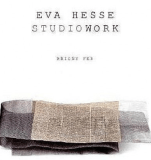“My interest is in finding my own way.”
—Eva Hesse, 1970
American artist Eva Hesse (1936–1970) played a central role in the transformation of sculpture that took place in the 1960s. In addition to her large-scale sculptures, over the course of her all-too-brief career, she produced a group of experimental works that are now recognized for their significance. Neither simply preparatory nor necessarily finished, these works—termed “studioworks” by art historian and exhibition curator Briony Fer—can be seen as capturing moments of experimentation, where Hesse is trying out ideas and techniques and discovering new possibilities. These fascinating sculptures dramatize and draw attention to the open-ended nature of Hesse’s oeuvre as a whole.
A close look at two of the works from the exhibition provides insight into how this rarely seen group of sculptures brings to light the inner workings of the artist’s process. Hesse is known for her experiments with a remarkable range of unusual materials. In Studiowork, 1968 (see second image in slideshow at left), a cluster of slender plastic tubes seem to sprout from a fiberglass base. Use of new, synthetic materials such as fiberglass, which changes color over time, allowed her to explore the temporal dimension of art, and to create work that interacts with light in a variety of ways. In this work, the lasting and the ephemeral coexist, as do the industrial and the organic, the solid and the hollow, and the transparent and the opaque. Hesse’s No title, 1996 (see third image in slideshow at left) is attached to the wall like a painting or drawing, but has palpable sculptural attributes, including a surface texture rough with marks, revealing the process of its own making, along with suggestive, pendulous shapes. The play of gravity, the sly tension between the taut and the curled “lines” created by the rope or the string—as well as between the two quirky, dangling objects—brings the sensual language of the body into the realm of minimal sculpture.
